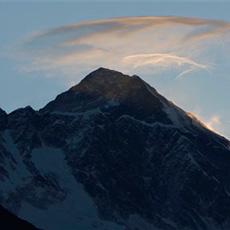
BOB DOUGHTY: This is SCIENCE IN THE NEWS, in VOA Special English. I'm Bob Doughty.
FAITH LAPIDUS: And I'm Faith Lapidus. This week, we will tell how coastal forests help to fight rising temperatures in Earth's atmosphere. We tell about efforts to clean up the highest mountain on Earth. And we tell about honors for three American scientists.
(MUSIC)
BOB DOUGHTY: A new report says mangrove forests store more planet-warming carbon dioxide than almost any other ecosystem on Earth. The report says loss of these forests is releasing large amounts of greenhouse gases in Earth's atmosphere.
Greenhouse gases trap warm air in the atmosphere. Most climate scientists believe the gases are responsible, at least in part, for climate change.
Mangrove forests are found along coasts in tropical countries. The warm water often serves as a home for fish and other creatures. The plants and trees also help protect coastal areas from storm damage.
FAITH LAPIDUS: The new report was published in the journal Nature Geoscience. Daniel Donato works with the United States Forest Service. He and his team studied tree mass, dead wood and soil carbon in 25 mangrove ecosystems in the Indian and Pacific Oceans.
Mr. Donato says these areas are among the most carbon-rich forests in the world. He found that mangroves store about three to four times more carbon per hectare as temperate forests or even tropical rainforests. But Mr. Donato says most of the carbon is hidden. The carbon is found mainly in the soil and tree roots.
BOB DOUGHTY: About one-third to one half of the world's mangrove forests have been cut down in the past 50 years. Some of the forests were cut for wood or wood products. Others were lost to coastal development or aquaculture.
Mangroves make up less than one percent of all tropical forests. Mr. Donato says the report should get the attention of policymakers.
DANIEL DONATO: "It shows mangroves are probably pretty good candidates for things like carbon-market trading to encourage sustainable forest management."
FAITH LAPIDUS: Some activists say carbon markets could be a powerful force for protecting the environment. In such a market, industries can buy the right to produce carbon dioxide in exchange for protecting forests or taking other steps.
Emily Pidgeon works for the group Conservation International. She says the value of the mangrove often is not clear to policymakers.
EMILY PIDGEON: "By suddenly having an actual mechanism to value these systems in dollars, it gives you a potentially very large new mechanism for countering the other financial and economic arguments."
BOB DOUGHTY: Other groups are considering the economics of mangrove protection from the buyer's side. They have urged Western supermarkets and other large buyers to only purchase farmed seafood that has little affect on mangrove loss.
Emily Pidgeon says one way to help developing countries value mangroves is to see them as something that provides many services. Those services could include protecting the fisheries that many coastal communities depend on for food and jobs. For many communities, carbon storage is just the latest service they may see mangroves providing.
(MUSIC)

FAITH LAPIDUS: There it stands...on the border of Nepal and Tibet ...8,850 meters high. Some natives call it Chomolungma, or "Goddess Mother of the World." But most people know it as Mount Everest, the highest mountain on earth.
The sky near the top is a beautiful blue color. New snow lies deep and white. Everything is clear and cold and clean. Or, at least, it once was clean. That was before people began to climb the mountain and leave behind thousands of kilograms of trash!
But help is on the way. Two mountain climbers from Nepal are leading a team that hopes to remove much of the trash.
BOB DOUGHTY: What kind of things have been left up there? The list is long. There are temporary shelters, ropes, oxygen bottles, clothing, sleeping bags, food...and bodies! Over 200 people have died trying to climb Mount Everest. Many of their bodies are still there, completely frozen.
This all started in 1921. British climbers were the first to try to reach the place called "the top of the world." They quickly discovered that going up was hard work. But getting back down safely was even more difficult. The first problem is the weather. It can change quickly. The temperature can quickly drop to 40 degrees below zero Celsius. Winds can reach hurricane speed. Fingers and toes freeze, even if they are covered in thick, protective material.
FAITH LAPIDUS: The next big worry is the lack of oxygen in the air. The higher a climber goes, the thinner the air. Areas near the top of the mountain have only about 30 percent of the oxygen found at sea level.
What climbers have learned is that they must carry a lot of oxygen bottles and other supplies up the mountain if they ever hope to reach the top. But because of the cold weather and lack of oxygen, many climbers become very sick. Getting off the mountain alive is hard enough. Cleaning up all the trash on the way down is nearly impossible.

BOB DOUGHTY: What about all those bodies left on Mt. Everest? Why are they still there? Experts say it is because they are too heavy to bring down. Climbers are told that, if they get sick high on the mountain, or fall and break a bone, they should not expect help. Many climbers have become so tired they have sat down to rest and never gotten up.
So Apa Sherpa, Dawa Steven Sherpa, and their team have decided to clean up the mountain. They will be paid a small amount for each kilogram of objects they bring down. But the team's leaders say the money is not important. They want to do this for their country, and the world.
FAITH LAPIDUS: There have been three other attempts in recent years to clean Mount Everest. But this is the first attempt at removing trash from the "Death Zone." That is the level above 8,000 meters. Up there, the thin air and cold can kill a person very quickly.
Apa Sherpa knows where to find much of the trash on Mount Everest. He has climbed to the top a record 20 times since 1990.
(MUSIC)
BOB DOUGHTY: Finally, the National Science Foundation will honor three leading scientists at a dinner tonight in Washington, DC. The three are being recognized for their success in science, engineering and technology.
The National Science Foundation, or NSF, is an independent agency of the federal government. It supports research and education in all areas of science and engineering.
Casey Dunn is a biologist at Brown University in Rhode Island. He is being honored for his work on animal evolution and the origins of biological complexity. His investigations have involved deep-sea creatures called siphonophores. The National Science Foundation says his work has helped increase understanding about how evolution affects the diversity of life.
Casey Dunn will receive the Alan T. Waterman Award. It is the NSF's highest honor for scientists 35 years old or younger. He will also receive 500,000 dollars over three years to help finance his research.
FAITH LAPIDUS: Another honoree is the President of the National Academy of Engineering, Charles Vest. He will receive the Vannevar Bush Award for his leadership in science and technology.
Mr. Vest served as president of the Massachusetts Institute of Technology from 1990 until 2004. He has also served as a director of the chemical company Dupont and of IBM. And he served on several federal committees.
BOB DOUGHTY: The NSF also plans to present its Public Service Award to Moira Gunn. She was the first woman to earn a PhD in mechanical engineering from Purdue University in Indiana. She currently serves as the managing director of Biotechnology Programs at the University of San Francisco.
Ms. Dunn is being recognized for increasing public understanding of science and engineering. In 1993, she created the radio program Tech Nation. The program examines the effect of science and technology on our everyday lives.
The National Science Foundation will also present a second Public Service Award Tuesday night. It is going to the Exploratorium museum in San Francisco.
(MUSIC)
FAITH LAPIDUS: This SCIENCE IN THE NEWS was written by Brianna Blake, Jim Tedder and June Simms, who was our producer. I'm Faith Lapidus.
BOB DOUGHTY: And I'm Bob Doughty. Join us again next week for more news about science in Special English on the Voice of America.
mangrove: a tropical tree that grows in mud or at the edge of rivers and sends roots down from its branches 红树林植物
siphonophore: 管水母类动物
Study warns of dangers to world's mangrove forests
Meet some top students in the Intel Science Talent Search
(来源:VOA 编辑:崔旭燕)
